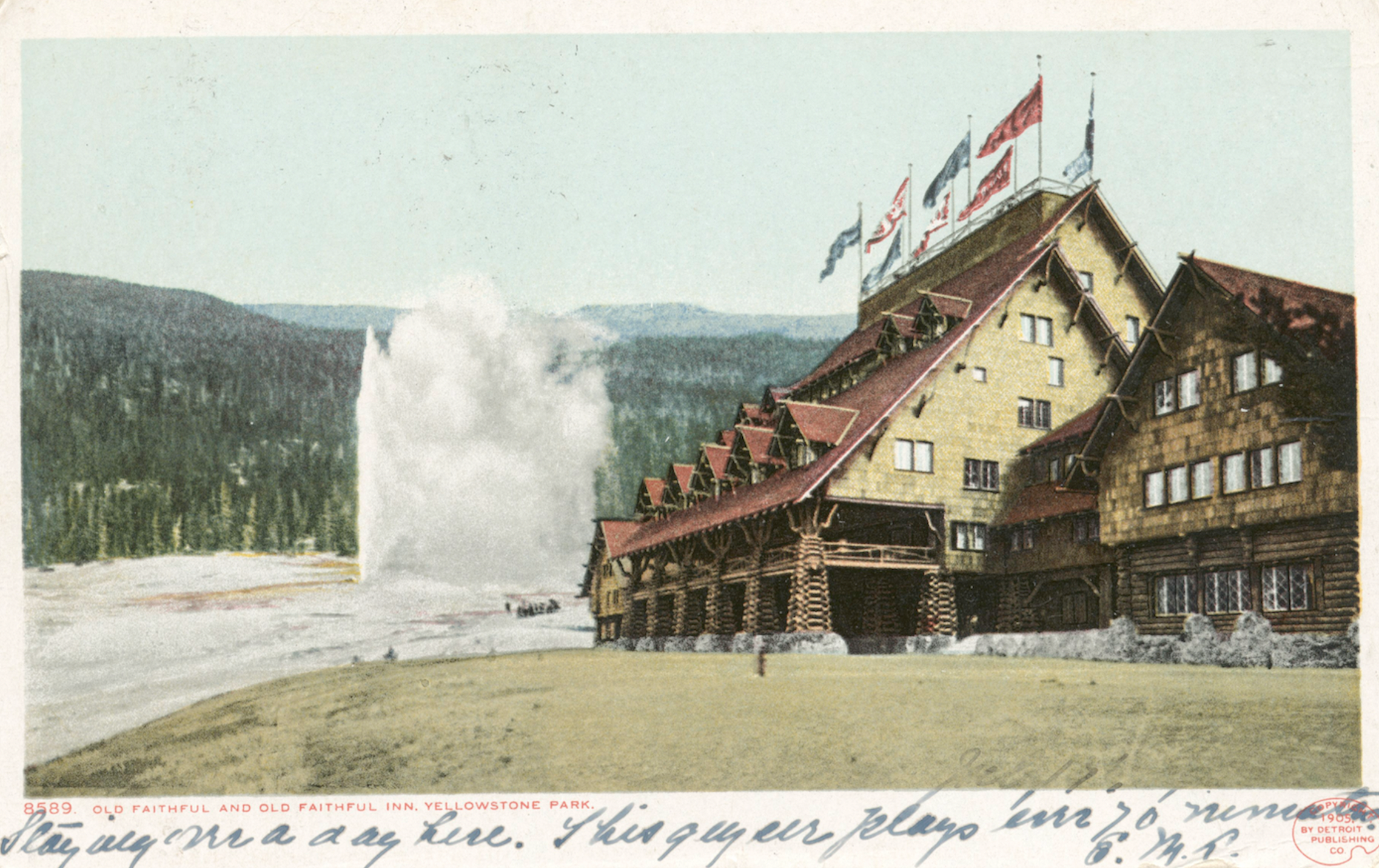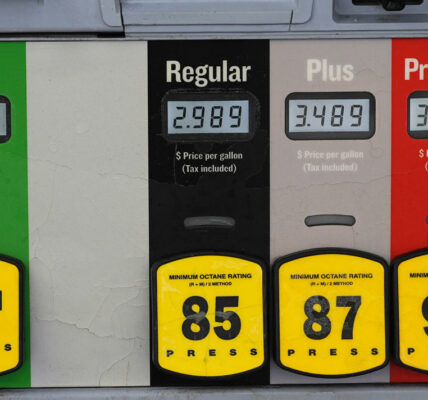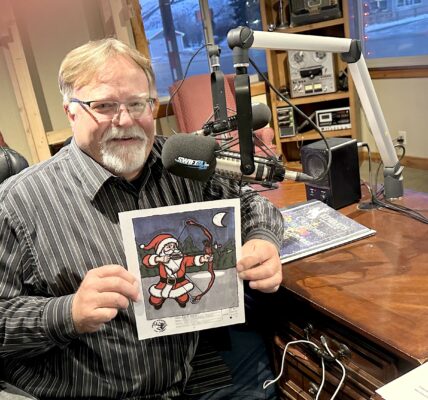Old Faithful Inn at $424: Who can still afford a Yellowstone road trip?

Camping isn’t for everybody, and lodging in the gateway communities and parks themselves has far outpaced inflation. Visitors and officials weigh in on whether the middle class is being priced out.
By Mike Koshmrl, WyoFile.com
OLD FAITHFUL — Liz Adkins saved for four or five months to afford for her family to visit Yellowstone National Park.
On a breezy, busy August afternoon a few minutes after Old Faithful spouted off, she explained how lunch got packed each morning to save a few bucks. Dinners were being made at the KOA campground in Cody, where Adkins’ family slept at night. There were few excesses during the Grand Rapids, Minnesota family’s long-planned journey to see Yellowstone’s 2.2 million acres, which were set aside “for the benefit and enjoyment of the people” some 152 years ago.
Adkins did, however, let WyoFile in on one splurge: “We’re planning to go to dinner on the last night,” she said with a chuckle.
Other luxuries, like a Cody hotel room, which started at around $200 a night, were out of reach for the dual-income family of five. Adkins works in the construction industry, and her husband’s paycheck comes from a boating business. Doing what they could to cut costs, the family managed to keep the total tab of their week’s road trip to about $2,000, she said.
Adkins has company in struggling to pull off what was once seen as an affordable summertime vacation for the middle-class: Road-tripping out West to gaze at bison, gawk at geysers and ogle waterfalls in Yellowstone National Park. There are a host of reasons an impromptu summertime trip has gotten pricier and more difficult to execute. Campgrounds get booked up months in advance. Inflation has generally outpaced wage growth nationally the last couple of years, but the cost of lodging in some gateway communities has risen even faster.
And Yellowstone often follows suit. In about half its rooms, Yellowstone determines the prices its largest concessionaire, Xanterra, is able to charge based on comparable rooms outside the park. Yellowstone has relinquished price controls in the other half of its rooms, including in iconic lodges like Lake Hotel and Old Faithful Inn. There, prices have climbed at an even faster clip.
In veteran Yellowstone tour guide Jesse O’Connor’s view, the increasing cost of a national park vacation has changed the profile of the typical visitor.
“It appears the national parks are gearing towards the higher end, and they are squeezing out the middle class,” said O’Connor, of Jackson. “The prices of the restaurants are going up, and [so are] the prices of the rooms. It seems everything is being inflated beyond what we’re making in increased wages.”
O’Connor has felt the pinch personally, and he’s tracked the climbing rates. Every other October since a 1991 honeymoon stay, he’s booked the exact same bathroomless room in the Old Faithful Inn. During the initial stay, the rate was $89. Figuring the Bureau of Labor Statistics inflation rate, the room would have climbed to $179 by the time of his last stay in October 2021. He paid $228, a 27% increase over the inflation-adjusted rate.
“It’s kind of sad. However I’m mostly agreeable with it because I looked at rooms in West Yellowstone,” O’Connor said. “You’re looking at $190 to $290 in West Yellowstone, if you book in advance.”
What the numbers say
The 120-year-old Old Faithful Inn, built from local logs and milled timber, is the most extreme example of how room rates in Yellowstone have spiked. Until 2018, Yellowstone told Xanterra what it could charge for the one-of-a-kind experience of staying in the historic lodge. That year the park and its Anschutz Corporation-owned concessionaire embarked on a pilot project that let Xanterra charge what the market would bear.
Turns out people are willing to pay a lot, and prices have skyrocketed: Average daily rates for an Old Faithful Inn room have climbed 55% over the past five years, jumping from $274 to $424, according to data provided by Yellowstone business chief Zach Allely.
Sometimes the floor price of a stay is higher yet. At the time of publication, Old Faithful room rates for one night on a Friday in late September started at $589.
Allely explained the theory of letting Xanterra set its own prices in places the park has dubbed “non-core” lodging — Old Faithful Inn, Lake Hotel and all of the Canyon lodging — where there are no price caps.
“You can’t compare the Old Faithful Inn to really anything else in the world,” Allely said. “It would be nice to have people stay in the Old Faithful Inn for $50 a night, but it’s just not realistic.”
Maintenance costs are extremely high, he said, and Xanterra has to put up its staff because of the isolated location. Plus, the law requires that the business has a “reasonable opportunity” to make a profit on its contract.
Prices have risen more gradually at other price-controlled “core” and free-market “non-core” lodging since the policy change, according to data Allely provided. Core lodges are typically newer and have more reasonable equivalents outside the park.
At price-controlled “core” Grant Village, the average daily rate swelled from $258 to $300, up 15%, from 2018 to 2022. The 2022 average rate at the “comparable” facility to Grant Village outside the park was $243. Over at the “core,” price-controlled Old Faithful Snow Lodge, average daily rates rose 21%, from $256 to $310. There, rates stayed well below the cost of the comparable out-of-park lodge, where average rates reached $411 by 2022.
The most affordable non-camping stay in Yellowstone was and is at price-controlled Roosevelt Lodge. Average daily rates for a cabin at the Tower Falls-area historic lodge increased 15%, from $107 to $123, over the last five years. Costs lagged well behind comparable cabins, where the average was $201 a night.
At free-market Lake Hotel, average daily rates went up 20% over the last five years, reaching $400. But on a bustling Thursday in early August, rooms were going for north of $600. That afternoon, Pat Scanlon, 79, was on his way into the 132-year-old hotel, Yellowstone’s oldest, when WyoFile intercepted him. The Arkansas resident worked there 56 years earlier as a twentysomething. His daughter did the same in 1995.
Lake Hotel visitors seemed “fairly affluent” back in the 1960s, Scanlon said, but the pricing in the modern era had jumped to a level that he found unacceptable. Vacationing with his wife, Patti, Scanlon stayed in a cabin outside the main hotel, and that cost them $440.
“We stayed at a Best Western Premium hotel in Cody last night for $350, so it’s more for a cabin here than it was for a really nice hotel room,” Scanlon said. “They’re pricing people out.”
Access for all?
That idea — that historic lodges are way out of reach for ordinary wage-earning Americans — did not sit well with MJ Basilone, who was visiting Yellowstone from Alaska.
“It’s not fair,” Basilone said. “It’s a national park.”
Basilone and her partner, Rick Farrell, are both military veterans. The National Park Service, she said, should be run similarly to defense agencies, and bottom lines shouldn’t be prioritized.
“They’re national parks, and they shouldn’t be run for a profit,” Basilone said. “The government should have a better handle on the pricing of lodging that’s in the park.”
Farrell and Basilone spent the night before in Jackson. They forked over $400 for a decent room at the Wyoming Inn of Jackson Hole, and were hit with sticker shock again when they went out to dinner. “$70 for a steak,” Basilone said. The slab of meat didn’t impress, the couple agreed.
There’s an argument to be made that some accommodations in Yellowstone and the other flagship national parks have always been expensive — and there’s always been ways to still pull off a trip. Tourist interest in Yellowstone, which attracts nearly 5 million visits annually, has risen steadily as the decades have lapsed, which suggests demand is not deterred by increasing costs.
National Park Service Director Chuck Sams grew up in a middle-class family that visited Yellowstone and the Tetons. Like the Adkins family, they had to save to make it happen.
“We saved up for years to go to Yellowstone,” Sams said at an early August media event in Grand Teton National Park. “We didn’t stay at the resorts — we couldn’t.”
National parks, Sams said, ought to be accessible to all: “Anybody should be able to come to the park,” he said, “and also see a reflection of themselves in the park.”
The Park Service has active dialog about affordability with its concessionaires, Sams said. Officials have looked at solutions through contracts, he said, and also at extending seasons to help deal with capacity issues and potentially ease pricing.
“We’re looking at all of those things,” he said.
Yellowstone has a long legacy of attracting and catering to the wealthy while leaving the door open for visitors of more modest means, according to O’Connor, the tour guide. He’s also a “passionate amateur historian” who’s a longtime volunteer with the Jackson Hole Historical Society.
“In the earliest days … there were two ways to see Yellowstone, you could be a dude or a sagebrusher,” O’Connor said. “I hate to say it, but the dudes were rich.”
Dudes took the train line from Chicago to Gardiner, Montana, he said, and tickets cost a fortune at the time. Sagebrushers, meanwhile, came by horse-drawn wagon and camped in the sage.
“This is my unexpected optimism: You can still do that,” O’Connor said. “You either camp, stay in a van or you can horsepack or backpack in. That’s the modern-day analogy to the sagebrushers of the 1880s.”
Doable, but difficult
Yellowstone’s dozen campgrounds contain over 2,000 campsites. Rates vary, but the National Park Service-administered sites go for $20 or $25 a night. Those managed by Xanterra run between $33 and $39 a night.
While the sites are much more affordable, don’t bank on rounding up the family and camping equipment and heading to Yellowstone on a whim, especially in the summertime. Every last campsite is reservable up to six months in advance in the summer, and oftentimes the entire park is sold out. It’s the same story in Grand Teton.
“It’s clear that because of the increased visitation, it’s probably more challenging for a family to come to Yellowstone,” said Mike Murray, who chairs the executive council for the Coalition to Protect America’s National Parks (formerly the The Coalition of National Park Service Retirees). “You have to plan ahead. You have to have reservations. Decades ago you could show up at the gate and find out which campgrounds had some vacant sites.”
Murray has worked on and off in Yellowstone for 45 years, both for a paycheck and as a volunteer. His first Park Service job was staffing an entrance station in 1978, and in the mid- to late-1990s he was Yellowstone’s assistant chief ranger. The cost of being a tourist at premiere national parks has gone up in general, he said, and increases in prices and crowding seem to be especially pronounced since the COVID-19 pandemic.
“You’re seeing record visitation numbers at a number of parks across the country,” Murray said. “I think people are still less interested in international travel, and parks have become even-more-popular destinations in many places.”
For the Coalition to Protect America’s National Parks, affordability is a “concern of sorts,” Murray said. But there are many concerns facing the National Park Service, he said.
“Parks are chronically underfunded,” he said. “As visitation has picked up, parks have been on the losing end of a 10-year decline in staffing.”
Superintendents have faced pressure to become “more entrepreneurial” to make up for the declining appropriations. “But there’s also a keen understanding that the more fees are increased, the more it discourages average Americans,” Murray said.
Fees to access and recreate in Wyoming and the Greater Yellowstone Ecosystem are going up, but for a typical road-tripping family the $35, seven-day vehicle fee is an inconsequential expense relative to the overall cost of the trip.
That overall trip cost is swinging up because of factors that are outside of the Park Service’s control. On average, a family of three staying three nights in a hotel or short-term rental in Park County spent $2,863 on a trip in 2022, according to the Wyoming Office of Tourism’s Economic Impact of Travel in Wyoming report. The same three-day trip in Teton County cost $3,490 on average.
Xanterra’s general manager for Yellowstone, Mike Keller, said he’s seeing sharp price increases on all sides of the national park. Rates, he said, have become “extremely more volatile and aggressive.”
“A hotel room in West Yellowstone or Gardiner that used to cost $80 is now going for $300 or $400,” Keller said. “That puts pressure on everything in the region.”
Xanterra’s rooms inside Yellowstone are not exempted. With inflation, wage growth and the additional costs of operating inside the national park, like meeting sustainability goals, it’s “not feasible” to operate on a $50 a night hotel room, Keller said.
Asked whether the socioeconomic profile of a typical guest lodging in Yellowstone is trending toward wealthier people, Keller said that was “private information.”
Keller echoed the aspiration that Yellowstone and the national parks ought to be affordable to all Americans. “Not just the middle class, not just the upper class,” he said. “Everybody should have the opportunity to see their parks.”
Minot, North Dakota resident Ron Fix had that opportunity this August. The main point of the trip was showing his 10-year-old daughter, Taylor, Yellowstone for the first time.
“We looked in the park [at lodging], and it was absolutely ridiculous,” Fix said. “$670 a night for a hotel, it’s a joke.”
But the Fixes were able to pull it off. They lodged in Cooke City for $135 a night, then spent sunup to sundown touring and hiking Yellowstone — and the trip was successful.
“She’s a hell of a hiker, I’ll tell you,” Ron Fix said. “It was a good time.”
WyoFile is an independent nonprofit news organization focused on Wyoming people,
places and policy.





